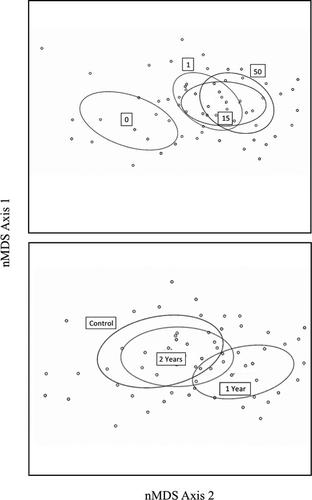当前位置:
X-MOL 学术
›
Ecol. Evol.
›
论文详情
Our official English website, www.x-mol.net, welcomes your
feedback! (Note: you will need to create a separate account there.)
Effects of fire on ground‐dwelling arthropods in a shrub‐dominated grassland
Ecology and Evolution ( IF 2.3 ) Pub Date : 2020-12-07 , DOI: 10.1002/ece3.7063 Anna Butler 1 , Craig A Davis 2 , Samuel D Fuhlendorf 2 , Shawn M Wilder 1
Ecology and Evolution ( IF 2.3 ) Pub Date : 2020-12-07 , DOI: 10.1002/ece3.7063 Anna Butler 1 , Craig A Davis 2 , Samuel D Fuhlendorf 2 , Shawn M Wilder 1
Affiliation

|
Arthropods are abundant and diverse animals in many terrestrial food webs. In western Oklahoma, some shrublands are interspersed with discrete, dense thickets of tall, woody vegetation, known as mottes. Some of these shrublands are managed with prescribed burning. The goal of this study was to examine whether prescribed burning interacted with habitat type (i.e., shrubland versus mottes) to affect ground‐dwelling arthropod communities. Arthropods were collected in pitfall traps at four sampling locations in relation to mottes; in the center of mottes, and three plot location in shrublands; 1 m, 15 m, and 50 m away from the edge of the motte. There were three treatment levels for burning: one year postburn (burned in dormant months of 2017), two years postburn (burned in dormant months of 2016), and unburned (burned in dormant season of 2014 and prior). There were no significant interactions between prescribed burning and habitat type. Mottes had a different community of arthropods compared with the surrounding shrubland. Mottes also had lower overall abundance, but a higher diversity of arthropods. In terms of fires, arthropod communities one year after burning were different from those two or more years after burning. There was no effect of burning on overall arthropod abundance, but plots that were one year since burning had significantly lower diversity compared with plots that were two or more years postburn. The results of this study suggest that both fire and mottes can independently facilitate heterogeneity in arthropod communities, but they do not appear to interact with one another.
中文翻译:

火灾对灌木草原中地面节肢动物的影响
节肢动物是许多陆地食物网中丰富多样的动物。在俄克拉荷马州西部,一些灌木丛中散布着离散而茂密的高大木本植物灌木丛,称为“mottes”。其中一些灌木丛通过规定的焚烧进行管理。本研究的目的是检查规定的燃烧是否与栖息地类型(即灌木丛与斑驳)相互作用,从而影响地面节肢动物群落。在四个与节肢动物相关的采样点的陷阱中收集节肢动物;在莫特斯的中心,以及灌木丛中的三个地块位置;距离土丘边缘1 m、15 m、50 m。烧伤分为三种处理级别:烧伤一年(2017年休眠月份烧伤)、烧伤两年(2016年休眠月份烧伤)和未烧伤(2014年及之前休眠季节烧伤)。规定的燃烧和栖息地类型之间没有显着的相互作用。与周围的灌木丛相比,莫特斯有不同的节肢动物群落。莫特斯的节肢动物总体丰度较低,但多样性较高。就火灾而言,燃烧一年后的节肢动物群落与燃烧后两年或更长时间的节肢动物群落不同。燃烧对节肢动物总体丰度没有影响,但与燃烧后两年或两年以上的地块相比,燃烧一年后的地块多样性显着降低。这项研究的结果表明,火和斑驳都可以独立促进节肢动物群落的异质性,但它们似乎并不相互作用。
更新日期:2021-01-08
中文翻译:

火灾对灌木草原中地面节肢动物的影响
节肢动物是许多陆地食物网中丰富多样的动物。在俄克拉荷马州西部,一些灌木丛中散布着离散而茂密的高大木本植物灌木丛,称为“mottes”。其中一些灌木丛通过规定的焚烧进行管理。本研究的目的是检查规定的燃烧是否与栖息地类型(即灌木丛与斑驳)相互作用,从而影响地面节肢动物群落。在四个与节肢动物相关的采样点的陷阱中收集节肢动物;在莫特斯的中心,以及灌木丛中的三个地块位置;距离土丘边缘1 m、15 m、50 m。烧伤分为三种处理级别:烧伤一年(2017年休眠月份烧伤)、烧伤两年(2016年休眠月份烧伤)和未烧伤(2014年及之前休眠季节烧伤)。规定的燃烧和栖息地类型之间没有显着的相互作用。与周围的灌木丛相比,莫特斯有不同的节肢动物群落。莫特斯的节肢动物总体丰度较低,但多样性较高。就火灾而言,燃烧一年后的节肢动物群落与燃烧后两年或更长时间的节肢动物群落不同。燃烧对节肢动物总体丰度没有影响,但与燃烧后两年或两年以上的地块相比,燃烧一年后的地块多样性显着降低。这项研究的结果表明,火和斑驳都可以独立促进节肢动物群落的异质性,但它们似乎并不相互作用。











































 京公网安备 11010802027423号
京公网安备 11010802027423号